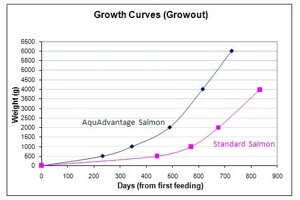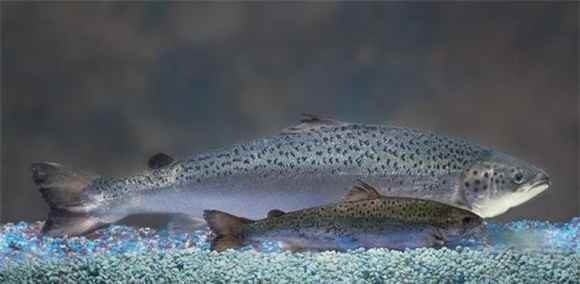GENETICALLY ENGINEERED FISH/AQUACULTURE
Genetically Engineered Salmon
Proponents claims that GE fish will help meet the world’s growing demand for seafood — but it may be that the costs to ocean and human health far outweigh any potential benefit.

Jumping Coho Salmon - Coho salmon in Beaver Creek, Canada. Photo: LouLou Beavers
A New and Troubling Way to Farm Fish
Right now, the FDA, under the agency's authority to review "new animal drugs,"i is considering whether to allow the production and sale of the first-ever genetically engineered animal for human consumption. AquaBounty Technologies, Inc. wants commercial approval of its AquAdvantage salmon, a farmed Atlantic salmon genetically engineered to grow twice as fast as natural salmon. The company claims that its fish will help meet the world’s growing demand for seafoodii—but it may be that the costs to ocean and human health far outweigh any potential benefit.
If the US Food and Drug Administration (FDA) approve the first genetically engineered animal for human consumption a new breed of farmed fish may soon be at your local grocer or seafood restaurant without you even recognizing it. If GE fish technology proliferates before we have answers to a host of critical questions, we'll be gambling with the health of our oceans, the economic well-being of our coastal communities and the safety of our seafood supply.
Environmental Impacts of Genetically Engineered Fish
The environmental consequences of farming genetically engineered fish, including salmon, are not fully understood—but what is known is troubling. We know that farmed fish can escape their enclosures, whether they are in land-based tanks or ocean-based net pens.iii Escaped genetically engineered salmon are likely to compete with wild fish, including endangered Atlantic salmon, for habitat, food, and mates.iv Research published in the Proceedings of the National Academy of Sciences found that the release of just 60 genetically engineered fish into a wild population of 60,000 could lead to the extinction of the wild population in less than 40 generations.vThere is still considerable debate about whether this "Trojan gene effect" would occur if AquaBounty's genetically engineered salmon escape. But the company's data, and FDA's conclusions based on analysis of that information, indicate that up to 5 percent of the eggs may not be sterile.vi
Growing genetically engineered salmon in contained, land-based facilities, the initial step being considered by the FDA, does not alleviate these concerns. Some re-circulated water is eventually released into the environment, providing an escape route for genetically modified fish or eggs. Land-based facilities are also subject to natural disasters, human error, or intentional sabotage. The New Animal Drug Application process used by the FDA does not fully address the scope of the environmental damage that could result should genetically engineered salmon or salmon eggs escape containment.vii
Human Health Impacts: Are Genetically Engineered Salmon Good for Us?
Beyond the environmental concerns of genetically engineered fish, the limited data made public by the company suggest that the product may pose food safety concerns as well. These concerns must be thoroughly evaluated before genetically engineered salmon is approved for human consumption. Some of the differences between genetically engineered salmon and conventional salmon include:viii
- Six chemicals (folic acid, niacin, vitamin B6, magnesium, phosphorus and zinc) are present in genetically engineered salmon at values that differ by more than 10 percent from conventional farmed salmon, indicating potential food quality differences among the two kinds of fish.
- The omega 3/omega 6 ratio in genetically engineered salmon is more than 12 percent less than in conventional farmed salmon, a difference that could be of interest to seafood consumers looking to maximize omega 3 levels in their own diets.
- Data indicate there may be higher levels of allergy-producing compounds in genetically engineered salmon, meaning the fish may pose a greater food allergy threat. Given the limited sample sizes, more study is needed to definitively rule out this concern.
- Levels of Insulin-like Growth Hormone (IGF-1) are elevated in genetically engineered salmon compared to conventional farmed salmon. The long-term health impacts of this are unclear, but IGF-1 is a known carcinogen.
- CARCINOGEN--> IS A SUBSTANCE DIRECTLY LINKED TO CAUSING CANCER!!
Genetically Engineered Salmon and the Future of Fish
The decision before the FDA could have consequences that go well beyond salmon. An FDA decision will mark a critical turning point for the future of our seafood supply. Should genetically engineered salmon be approved, it will be nearly impossible to reverse course once the "genie is out of the bottle," especially if labeling is not required. Approval could pave the way for the proliferation of other species of genetically engineered fish and, in so doing, fundamentally alter the nature of our seafood supply.
Our ocean is our life support system, and a bountiful wild fish supply is one of its most precious resources. Over a billion people rely on fish as their primary source of protein,xvi and billions more value fish for sport and tourism. Wild fisheries also produce enormous economic benefits to coastal communities and throughout the economy estimated at more than $90 billion each year.xvii Decisions about the future of fish farming – including the role of genetically engineered fish – should not be made in isolation, or in ways that threaten the health of our ocean.
Ocean Conservancy is calling for a comprehensive Environmental Impact Statement before a decision is made on genetically engineered salmon. And we are calling for mandatory labeling of any genetically engineered fish or genetically engineered fish product sold to U.S. consumers. Only then will consumers have the information they need to avoid it in the marketplace if they so choose.
SOURCE: http://www.oceanconservancy.org/our-work/aquaculture/aquaculture-genetically.html
FDA APPROVAL FOR GENETICALLY MODIFIED SALMON THAT GROW SUPER FAST
One particular genetically modified salmon is on the verge of successfully navigating the treacherous regulatory waters of the FDA. The agency just issued a draft environmental assessment of the genetically engineered salmon in which they asserted that the salmon “would not have a significant impact on the US environment.” The agency also concluded the salmon to be “as safe as food from conventional Atlantic salmon.” If all goes as expected, the salmon could be available for consumers by late next year.
The genetically modified salmon are produced by AquaBounty Technologies, based in Maynard, Massachusetts. Their AquAdvantage salmon are Atlantic salmon that combine a growth hormone gene from Chinook salmon and a control gene from an eel-like creature called the ocean pout that cranks out the growth hormone. The result is that the AquAdvantage salmon grow faster, cutting the time to reach market weight by about half – 18 months compared instead of three years required by normal salmon. Despite the accelerated growth rate, the resultant salmon don’t grow to be any larger than their wild counterparts.
AquaBounty Technologies have sought FDA approval for about 17 years. The FDA had previously determined that the salmon were safe to eat but had yet to rule on whether or not they were safe for the environment. The current draft assessment will be posted on the FDA website for the next 60 days over which time the public is invited to voice concerns over the salmon. Approval is expected to follow the open comment period.
PLEASE MAKE SURE YOU DO THIS TO SAVE THE SALMON AND YOUR FRIENDS AND FAMILY!
The FDA decision has infuriated some environmental and consumer groups. Andrew Kimbrell, executive director of the advocacy group Center for Food Safety that opposes farm biotechnology, calls the agency’s decision “premature and misguided.” He said in astatement that “the G.E. salmon has no socially redeeming value. It’s bad for the consumer, bad for the salmon industry and bad for the environment.” The group’s statement goes on to say that the FDA’s decision ignores the recommendations of more than 40 members of Congress for more rigorous reviews of the environmental and health effects of the salmon and near 400,000 comments from the public urging the FDA to reject the application.
A major concern among opponents is the risk that the AquAdvantage salmon could escape into the wild and outcompete normal salmon for food or mates. But the multiple layers of protection against this scenario has led the FDA to call the risk “extremely remote.”

A combination of proteins taken from the Chinook salmon and the ocean pout cause it to grow twice as fast as wild salmon. The abnormal growth rate has raised concerns among consumer groups.
First, the salmon would be reared inside inland tanks in Panama that are equipped with multiple barriers to prevent escape. And even if some salmon do manage to pass the barriers the surrounding Panamanian waters would be too warm or salty for the Atlantic fish to survive (eggs are taken from plants on Prince Edward Island, Canada). Lastly, the AquAdvantage salmon will be sterilized and unable to breed, although the sterilization procedure is acknowledged to not be foolproof.
AquaBounty rejects the environmental risk argument and assert that the accelerated growth of their fish and the shortened time to market actually decrease their environmental impact by enabling them to be grown in inland tanks instead of ocean pens that can wear on their ocean surroundings.
It’s important to point out that the FDA only assessed how the salmon might affect surrounding environs in the US, but not in Panama or Canada.
In addition to environmental concerns, opponents are concerned that the FDA’s previous assessment that the AquAdvantage salmon are safe to eat was not thorough enough.
The FDA will take some time, perhaps a few months, to consider comments from consumers before making a final decision. If they maintain their current stance that the salmon are safe an additional approval would then allow the salmon to be sold in the US. Ronald Stotish, AquaBounty’s chief executive, told the New York Times that if the fish are approved next year the genetically modified fish could reach American dinner tables by late 2013. Initial supplies would be limited given that the Panama farm is currently the only one growing the fish. But AquaBounty plans on selling the modified eggs to other fish farms to boost their salmon supply.
The FDA decision is a major victory for genetically modified foods. If the fish do end up on dinner plates across the US – and it certainly appears as though they will – the AquAdvantage salmon could pave the way for genetically modified foods of all kinds. No doubt we are in for a prolonged battle between opposition groups and companies like AquaBounty working to be major players in a potentially extremely profitable market. The battle with play out on our dinner plates as the foods are shown to be safe for us or not, and at the fish farms and crop fields as they are shown to be safe for the environment or not. It’ll be a grand experiment with implications for the future of our food, and with heavily vested interests on all sides.
SOURCE:http://singularityhub.com/2013/01/02/fda-approval-for-genetically-modified-salmon-that-grow-super-fast/

No comments:
Post a Comment
I would love to hear from you
Tori<3